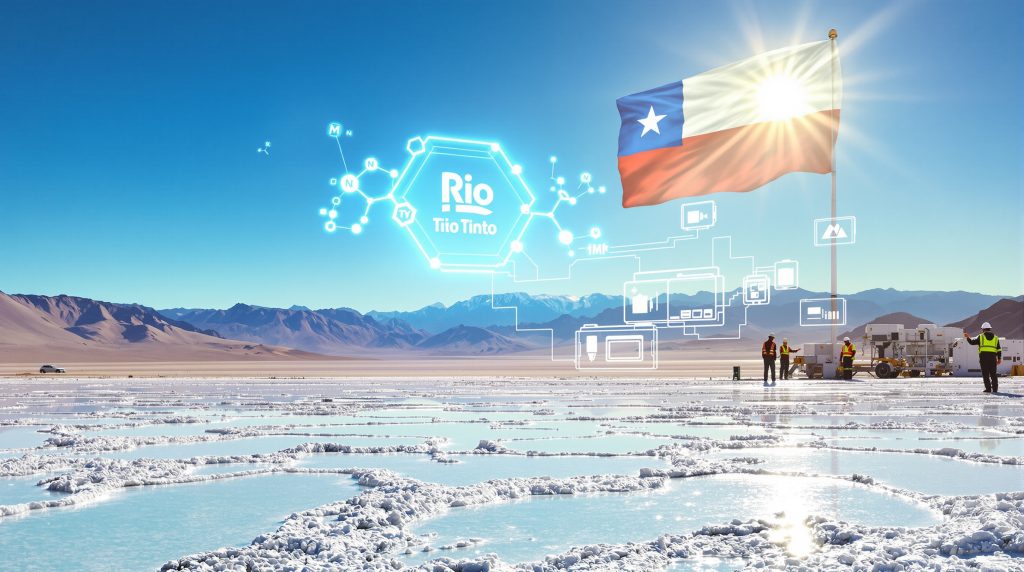Understanding Chile's Lithium Contract with Rio Tinto: Strategic Implications for Global Supply
Chile's recent lithium contract with Rio Tinto marks a significant development in the global lithium landscape. The partnership focuses on the Altoandinos project and represents Chile's evolving approach to managing its vast lithium resources. This collaboration between state-owned ENAMI and mining giant Rio Tinto signals Chile's strategic positioning in the expanding electric vehicle and energy storage markets.
What is the Altoandinos Lithium Project?
The Altoandinos lithium project represents one of Chile's most significant lithium developments in recent years. Located in Chile's mineral-rich northern region, the project sits within the famed "Lithium Triangle" that spans parts of Chile, Argentine lithium brine insights, and Bolivia—an area containing over 75% of the world's known lithium reserves.
According to Chile's Mining Ministry, the lithium operating contract for the Altoandinos project is ready to be signed, with state mining company ENAMI set to operate the project in partnership with global mining giant Rio Tinto. This arrangement reflects Chile's strategic vision for developing its lithium resources through carefully structured public-private partnerships.
Project Overview and Location
The Altoandinos project is situated in Chile's Atacama region, known for its exceptional lithium concentrations and favorable extraction conditions. The area's unique geological characteristics provide naturally occurring lithium brines with high concentration levels, making extraction potentially more economical than many competing global deposits.
The project forms part of Chile's broader lithium portfolio, which includes some of the world's most productive lithium operations. The Atacama Salt Flat, where many of Chile's lithium operations are based, offers lithium concentrations that can reach up to 1,500 parts per million—significantly higher than many competing resources globally.
Key Partnership Structure
At the core of the Altoandinos project is a partnership between:
- ENAMI (Empresa Nacional de Minería): Chile's state-owned mining company will operate the project, maintaining governmental control over this strategic resource
- Rio Tinto: The global mining giant brings technical expertise and financial resources as the technical and financial partner
- Public-private framework: This structure reflects Chile's revised national approach to lithium development, balancing state interests with private sector capabilities
This partnership model represents a strategic evolution in Chile's approach to lithium development, moving away from simple concession models toward more collaborative arrangements that maintain state involvement while leveraging private sector expertise and capital.
How Does This Contract Fit into Chile's New Lithium Strategy?
Chile's approach to lithium development has undergone significant transformation in recent years, reflecting the increasing strategic importance of this resource in global energy transition efforts.
Evolution of Chile's Lithium Policy
Chile has historically classified lithium as a strategic material, subject to special regulations distinct from other minerals. This classification stems from lithium's applications in nuclear fusion technology, though today its importance lies primarily in its role in energy storage and electric mobility.
The partnership with Rio Tinto exemplifies Chile's shift from traditional concession models toward a more collaborative approach that:
- Maintains stronger state control over strategic resources
- Leverages private sector expertise and capital
- Ensures Chilean citizens benefit more directly from resource extraction
- Establishes frameworks for sustainable and responsible development
This evolution reflects lessons learned from Chile's earlier lithium development phases, where critics argued that excessive focus on private concessions limited the public benefits from these strategic resources.
Economic and Strategic Objectives
Chile's revised lithium strategy encompasses several core objectives:
- Value maximization: Ensuring the country captures a greater proportion of the value chain rather than simply exporting raw materials
- Sustainable development: Implementing extraction methods that minimize environmental impacts, particularly regarding water usage in Chile's arid northern regions
- Supply chain positioning: Strengthening Chile's competitive position in global lithium market trends as demand accelerates with electric vehicle adoption
- Industrial development: Creating opportunities for domestic processing and manufacturing to generate higher-value economic activities
The Altoandinos partnership aligns with these objectives by establishing a framework where state involvement helps ensure these strategic goals remain central to the project's development.
What Makes the Rio Tinto Partnership Significant?
The selection of Rio Tinto as Chile's partner for the Altoandinos project carries particular significance in the global mining landscape and reflects careful strategic considerations.
Rio Tinto's Global Lithium Ambitions
For Rio Tinto, the Altoandinos project represents part of a broader strategic pivot toward materials essential for the energy transition. As one of the world's largest mining companies, Rio Tinto brings several advantages to this partnership:
- Extensive experience managing large-scale mining operations across multiple continents
- Advanced technical capabilities in resource extraction and processing
- Substantial financial resources to support capital-intensive development
- Established relationships with downstream manufacturers and battery producers
- Growing focus on sustainability and responsible mining practices
Rio Tinto has been actively expanding its lithium portfolio, recognizing the metal's crucial role in future energy systems. The company has pursued lithium assets in Serbia, Argentina, and the United States, positioning the Altoandinos project as a key component of its growing battery metals strategy.
Competitive Positioning
Chile's selection of Rio Tinto came amid intense competition from other major mining companies seeking to secure access to lithium resources. The decision likely reflects several strategic considerations:
- Rio Tinto's technical approach to extraction and its alignment with Chile's sustainability requirements
- The company's willingness to accept partnership terms that maintain significant state involvement
- Potential synergies with Chile's broader mining sector development goals
- Rio Tinto's established compliance systems for environmental and social standards
This partnership positions Chile competitively within evolving battery supply chains, potentially enabling preferential access to manufacturers seeking reliable, responsibly-sourced lithium supplies.
What Are the Economic Implications for Chile?
The Altoandinos project carries significant economic implications for Chile, extending beyond direct revenues to broader industrial development opportunities.
Revenue and Investment Projections
While specific financial projections for the Altoandinos project haven't been publicly disclosed, lithium projects of similar scale typically involve:
- Initial capital investments ranging from $500 million to $1.5 billion
- Development timelines of 3-5 years from approval to production
- Operating lifespans exceeding 20 years with proper resource management
- Potential annual revenues in the hundreds of millions once at full production
Chile's revenue capture will depend on the specific partnership structure negotiated with Rio Tinto, but modern agreements typically include:
- Royalty payments based on production volumes or sales
- Profit-sharing arrangements from operational proceeds
- Tax revenues from corporate income and related activities
- Potential dividend payments through ENAMI's project participation
The project also promises significant employment benefits, with lithium operations typically creating hundreds of direct jobs and thousands of indirect positions throughout the supply chain and supporting industries.
Value Chain Development
A key strategic consideration for Chile extends beyond simple extraction to developing downstream processing capabilities and capturing more of the lithium value chain within the country. Potential opportunities include:
- Lithium carbonate and hydroxide production facilities
- Cathode material manufacturing for battery applications
- Research and development centers focused on lithium technologies
- Supporting industries providing equipment, services, and expertise
Success in these areas would transform Chile from primarily a raw material supplier to a more integral participant in the global battery supply chain, significantly enhancing the economic benefits from its lithium resources.
How Will This Impact Global Lithium Supply?
The Altoandinos project enters a rapidly evolving global lithium market, where demand projections have accelerated dramatically with electric vehicle adoption rates exceeding earlier forecasts.
Production Capacity and Timeline
While specific production targets for Altoandinos haven't been disclosed, lithium projects of comparable scale typically:
- Target production capacities of 25,000-50,000 tonnes of lithium carbonate equivalent (LCE) annually
- Require 3-5 years from approval to initial production
- Follow phased development approaches, gradually scaling to full capacity
- Represent investments of several hundred million to over a billion dollars
These parameters would position Altoandinos as a significant contributor to global lithium supply, potentially accounting for 5-10% of current global production once fully operational.
Market Impact Assessment
The Altoandinos project will enter a market characterized by:
- Rapidly accelerating demand driven primarily by electric vehicle battery production
- Growing energy storage applications for grid stabilization and renewable integration
- Tight supply conditions as development timelines lag behind demand growth
- Strategic positioning by manufacturers to secure reliable supply chains
The project's impact on global markets will depend on its development timeline relative to competing projects globally, particularly those in Australia, Argentina, and North America. As a Chilean project with major mining company backing, Altoandinos may be perceived as a relatively lower-risk development compared to projects in less established mining jurisdictions.
What Environmental and Social Considerations Are Involved?
Lithium production carries significant environmental and social considerations, particularly in Chile's water-stressed northern regions.
Sustainability Framework
The Altoandinos project will face several critical environmental challenges:
- Water management: Lithium brine operations typically require substantial water resources in regions where water is already scarce. Modern projects increasingly implement closed-loop systems and efficiency measures to minimize consumption.
- Energy requirements: Processing facilities demand significant energy inputs, creating opportunities for renewable integration in Chile's solar-rich northern regions.
- Land usage and ecosystem impacts: Brine operations involve large evaporation ponds that can affect local ecosystems and landscapes.
Chile's lithium regulations have evolved to place greater emphasis on environmental performance, likely requiring Rio Tinto to implement leading practices in water conservation, renewable energy utilization, and habitat protection.
Community Engagement
Successful lithium projects increasingly depend on meaningful community engagement and benefit-sharing. Key considerations include:
- Indigenous consultation: Many lithium-rich areas overlap with territories of indigenous communities, requiring careful consultation processes and respect for traditional rights.
- Local employment: Creating opportunities for community members throughout the project lifecycle.
- Infrastructure development: Contributing to regional infrastructure improvements that benefit broader communities.
- Education and training: Developing local skills to maximize community participation in the project.
Chile's evolving lithium framework places greater emphasis on these social dimensions, likely establishing specific requirements for Rio Tinto regarding community engagement and benefit-sharing.
What Challenges Could Affect Project Implementation?
Despite its strategic importance, the Altoandinos project faces several potential implementation challenges that could affect its development timeline and ultimate success.
Regulatory and Political Factors
Chile's lithium sector operates within a complex regulatory environment that presents several challenges:
- Evolving regulatory frameworks: Chile's approach to lithium has undergone significant changes, creating uncertainty regarding future requirements and expectations.
- Permitting processes: Securing necessary environmental, water, and operational permits involves multiple agencies and potential delays.
- Political considerations: Lithium has become increasingly politicized in Chile, with debates regarding appropriate levels of state involvement and benefit distribution.
- Stakeholder management: Balancing the interests of local communities, environmental organizations, industry participants, and government entities requires careful navigation.
These factors could potentially extend development timelines beyond initial projections, affecting the project's economic returns and market impact.
Technical and Operational Considerations
Beyond regulatory challenges, the project faces several technical and operational considerations:
- Extraction technology selection: Choosing between traditional solar evaporation methods and newer direct lithium extraction (DLE) technologies, each with different implications for water usage, energy requirements, and production timelines.
- Water access: Securing sustainable water sources in Chile's arid northern regions, potentially requiring desalination or other advanced water management approaches.
- Infrastructure development: Building or upgrading transportation, energy, and processing infrastructure to support operations.
- Workforce development: Recruiting and training qualified personnel for specialized roles throughout the operation.
Rio Tinto's experience with large-scale mining operations provides advantages in addressing these challenges, though the specific requirements of lithium production may differ from the company's traditional mining activities.
How Does This Contract Compare to Other Global Lithium Developments?
The Altoandinos project enters a global landscape where lithium development approaches vary significantly by region and regulatory framework.
Comparative Analysis with Other Major Projects
Chile's approach through the Altoandinos partnership contrasts with development models in other major lithium-producing regions:
- Australia: Primarily private development through traditional mining concessions, focusing on hard-rock lithium sources (spodumene) rather than brines.
- Argentina: Provincial-level concession systems with varying requirements regarding state participation and local benefits.
- United States: Primarily private development with federal permitting requirements but limited direct government participation in projects.
- Bolivia: State-centric approach with limited foreign participation, focusing on maintaining national control throughout the value chain.
Chile's model represents a middle path, maintaining state involvement through ENAMI while leveraging Rio Tinto's capabilities and capital—potentially offering advantages in balancing development pace with public benefit capture.
Global Lithium Market Context
The Altoandinos project will operate within a global lithium market characterized by:
- Accelerating demand growth driven primarily by electric vehicle adoption
- Evolving battery chemistries that may affect specific lithium product requirements
- Growing emphasis on responsible sourcing and environmental performance
- Strategic positioning by major economies to secure battery supply chains
Within this context, Chile's established position as a leading lithium producer and Rio Tinto's global standing could position Altoandinos favorably, particularly as manufacturers increasingly prioritize supply security and sustainability credentials.
What Does This Mean for Investors and Industry Watchers?
The Altoandinos partnership carries significant implications for various stakeholders across the lithium value chain and broader mining sector.
Investment Implications
For investors, the Altoandinos development signals several important trends:
- Rio Tinto's strategic evolution: The company's increased focus on battery metals represents a significant pivot, with implications for long-term valuation and growth potential.
- Chile's investment climate: The partnership structure may influence perceptions of Chile's approach to foreign investment in strategic sectors.
- Lithium market development: The project's advancement affects projections of future supply-demand balance and price trajectories.
- Valuation benchmarks: The partnership terms and investment parameters may establish reference points for valuing other lithium assets globally.
Industry analysts will likely watch the project's development timeline, capital efficiency, and operating parameters as indicators for the broader lithium sector's evolution.
Industry Trend Analysis
Beyond specific investment considerations, the Altoandinos project reflects several important industry trends:
- Evolving partnership models: Moving beyond simple concessions toward more collaborative frameworks between governments and private companies.
- Technical innovation: Potential adoption of newer extraction technologies to address environmental concerns and improve efficiency.
- Supply chain integration: Growing linkages between resource development and downstream manufacturing.
- Sustainability emphasis: Increasing focus on environmental performance and community benefits as core development parameters.
These trends may influence development approaches across the broader mining sector, particularly for materials critical to energy transition technologies.
FAQ: Chile's Lithium Contract with Rio Tinto
What is the significance of the Altoandinos lithium project?
The Altoandinos project represents a strategic evolution in Chile's approach to lithium development, establishing a partnership model that maintains state involvement while leveraging private sector expertise. The project will strengthen Chile's position in global lithium markets at a time of accelerating demand for battery materials, potentially creating significant economic benefits through direct revenues, employment, and industrial development opportunities.
How does Chile's lithium strategy compare to other producing nations?
Chile's approach differs significantly from other major lithium producers. Australia relies primarily on private development of hard-rock resources with limited government involvement beyond regulatory oversight and taxation. Argentina employs a provincial concession system with varying requirements for local participation. Bolivia has pursued a highly state-centric approach with limited foreign involvement. Chile's model represents a middle path, maintaining significant state involvement through ENAMI while partnering with global mining companies for technical expertise and capital.
What timeline can be expected for project development?
While specific timelines haven't been disclosed, lithium projects of comparable scale typically require 3-5 years from approval to initial production. Development often follows a phased approach, with production capacity gradually increasing over several years. Key milestones will include final contract signing, environmental permitting, construction commencement, and commissioning of processing facilities. Regulatory processes, particularly environmental approvals and water rights, often represent critical path items that can significantly influence development timelines.
Disclaimer: This article contains projections and analyses based on current information about the Altoandinos project and broader lithium market trends. Actual project parameters, timelines, and market impacts may differ from these projections. Readers should consult multiple sources and professional advisors before making investment or business decisions related to the lithium sector.
Chile's Lithium Ambitions in the Global Energy Transition
Chile's lithium strategy, exemplified by the Altoandinos partnership with Rio Tinto, positions the country to play a crucial role in the global energy transition. As the world accelerates toward electrification of transportation and renewable energy integration, lithium demand projections continue to be revised upward.
The International Energy Agency estimates that lithium demand could increase by over 40 times by 2040 in a scenario aligned with global climate goals. This explosive growth creates both opportunities and challenges for producing regions like Chile.
Technological Developments Affecting Lithium Production
Technological innovation continues to reshape lithium production approaches, with implications for the Altoandinos project:
- Direct Lithium Extraction (DLE): Newer technologies promise reduced water consumption, smaller physical footprints, and faster production timelines compared to traditional evaporation approaches.
- Digitalization and automation: Advanced monitoring and control systems can optimize resource usage and reduce environmental impacts.
- Renewable energy integration: Solar power can reduce operational carbon footprints, particularly relevant in Chile's sun-rich northern regions.
- Water efficiency innovations: Closed-loop systems and advanced water treatment approaches can minimize consumption in water-stressed regions.
Rio Tinto's technical capabilities may accelerate the adoption of these innovations at Altoandinos, potentially establishing new benchmarks for the industry.
Strategic Resource Nationalism Considerations
Chile's approach to lithium development reflects a broader global trend toward strategic resource management for critical minerals. This "resource nationalism" takes various forms:
- Increased state participation in projects
- Higher taxation or royalty requirements
- Local content and processing requirements
- Export restrictions or quotas
Chile's model attempts to balance these national interest considerations with the need to attract investment and expertise. The success of this balance with Rio Tinto will likely influence approaches in other lithium-rich regions globally.
Looking Ahead: Chile's Lithium Future
The Altoandinos project represents just one component of Chile's broader lithium strategy. The country's lithium reserves and established production position it to remain a key global supplier for decades, provided it can:
- Successfully implement partnership models that deliver both public and private benefits
- Address environmental challenges, particularly water usage in arid regions
- Develop battery-grade lithium refinery capabilities to capture more value domestically
- Navigate evolving political landscapes regarding resource development
The Rio Tinto partnership provides a test case for this strategy, with implications extending far beyond a single project to Chile's broader position in the global energy transition landscape. Furthermore, the success of this project could inspire similar approaches in other regions exploring geothermal lithium extraction or developing lithium industry innovations to meet growing global demand.
Ready to Capitalise on the Next Major Mineral Discovery?
Track significant ASX mineral discoveries in real-time with Discovery Alert's proprietary Discovery IQ model, transforming complex mineral data into actionable investment insights. Explore why historic discoveries generate substantial returns by visiting Discovery Alert's dedicated discoveries page and start your 30-day free trial today.




